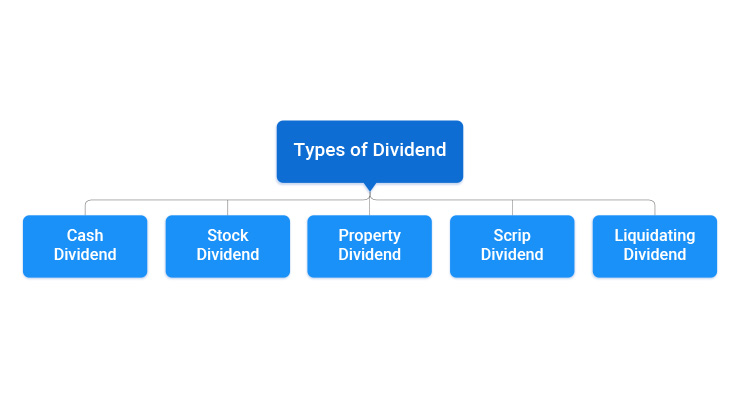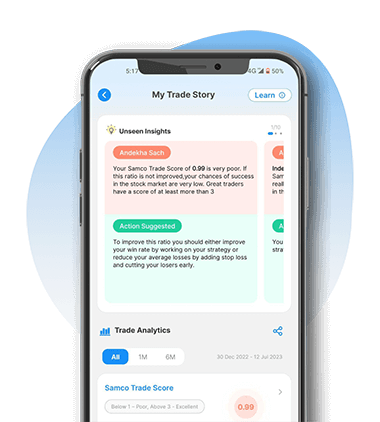Typically any company is engaged in the value generation for customers in the form of products and services. For the efforts of the company, it charges a small proportion of additional money known as profit. If any generates profits then it could either reinvest profits into the business or it could give the capital to its investors in the form of dividend.
Dividends are given so as :
- To increase the faith of retail investors in the company.
- To send a signal to investors about companies optimism towards future earnings.
While doing so, the company may choose different ways of paying out dividend. A company can also decide the frequency of paying out the dividend, meaning it can give it annually, monthly or quarterly. This is solely dependent of the dividend policy of the company.
There are following types of dividend options with the company.
- Cash dividend
- Stock dividend
- Property dividend
- Scrip dividend
- Liquidating dividend

Cash Dividend Example On February 1, Samco's board of directors declares a cash dividend of 2 Rs per share on the company's 2,000,000 outstanding shares, to be paid on Jan 26 to all shareholders of record on Jan 10. On Jan 1, the company records this entry:
| Debit | Credit | |
| Retained earnings | 1,000,000 | |
| Dividends payable | 1,000,000 |
On Jan 26, Samco pays the dividends, and records the transaction with this entry:
| Debit | Credit | |
| Dividends payable | 1,000,000 | |
| Cash | 1,000,000 |
After Jan 26 within next few days all the shareholders will receive the money in their linked bank accounts.
2) Stock dividend: If any company issues additional shares to common shareholders without any consideration then the action becomes stock dividend. If the company issues less than 25% of the previously issued stocks then it will be treated as the stock dividend. If the issuance of new shares is more than 25% of the last issue shares then it is treated as the stocksplit.
Stock Dividend Example Samco declares a stock dividend to its shareholders of 10,000 shares. The fair value of the stock is Rs 200, and its par value is Rs 1. Samco records the following entry:
| Debit | Credit | |
| Retained earnings | 50,000 | |
| Common stock, Rs 1 par value | 10,000 | |
| Additional paid-in capital | 40,000 |
3) Property dividend: Any company can issue any non-monetary dividend to its shareholders. The issued property dividend would be recorded against the current market price of the asset distributed. As the market price of the asset is expected to be either above or below the book value therefore it would either incur profit or loss and accordingly would be entered in the books. This interpretation of the distributed asset may force businesses to intentionally issue the property dividend to manipulate the taxable income.
Property Dividend Example Samco's board of directors elects to declare a special issuance of 500 identical, signed prints by Pablo Picasso, which the company has stored in a vault for a number of years. The company originally acquired the prints for Rs 500,000, and they have a fair market value as of the date of dividend declaration of Rs 4,000,000. Samco records the following entry as of the date of declaration to record the change in value of the assets, as well as the liability to pay the dividends:
| Debit | Credit | |
| Long-term investments - artwork | 3,500,000 | |
| Gain on appreciation of artwork | 3,500,000 |
| Debit | Credit | |
| Retained earnings | 4,000,000 | |
| Dividends payable | 4,000,000 |
On the dividend payment date, Samco records the following entry to record the payment transaction:
| Debit | Credit | |
| Dividends payable | 4,000,000 | |
| Long-term investments - artwork | 4,000,000 |
4) Scrip dividend : When any company doesnt have enough funds to pay dividend then it may choose to pay dividend in the form of promissory note to pay the shareholders at a later date. This essentially creates a note payable.
Scrip Dividend Example Samco International declares a Rs 250,000 scrip dividend to its shareholders that has a 10 percent interest rate. At the dividend declaration date, it records the following entry:
| Debit | Credit | |
| Retained earnings | 250,000 | |
| Notes payable | 250,000 |
The date of payment is one year later, so that ABC has accrued Rs 25,000 in interest expense on the notes payable. On the payment date (assuming no prior accrual of the interest expense), Samco records the payment transaction with this entry:
| Debit | Credit | |
| Notes payable | 250,000 | |
| Interest expense | 25,000 | |
| Cash | 275,000 |
5) Liquidating dividend: When the board of the company thinks of returning the original capital invested by the shareholders then it is known as the liquidating dividend. This may happen due to the fact the company intends to wrap up the business.
Liquidating Dividend Example Samco’s board of directors declares a liquidating dividend of Rs 1,600,000. It records the dividend declaration with this entry:
| Debit | Credit | |
| Additional paid-in capital | 1,600,000 | |
| Dividends payable | 1,600,000 |
On the dividend payment date, Samco records the following entry to record the payment transaction:
| Debit | Credit | |
| Dividends payable | 1,600,000 | |
| Cash | 1,600,000 |
Also read the article highlighting the 30 Highest Dividend Paying Stocks in India For more useful articles on trading, investing and market knowledge, visit our Knowledge Center section.
(Note: The above list is for information purpose only. Avoid trading and investing based on the information given above. Before investing in stocks do due diligence).






Leave A Comment?